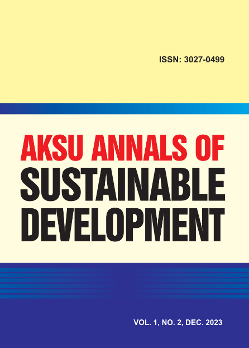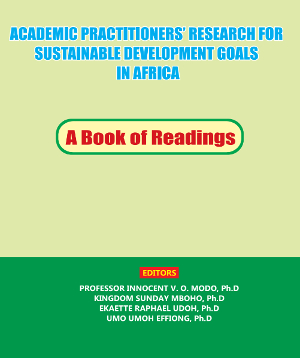DISEASE PREVALENCE AND INFANT MORTALITY IN THE RURAL AREAS OF AKWA IBOM STATE, NIGERIA
https://doi.org/10.60787/AASD-1-2-9
Keywords:
Infant Mortality and Rural Areas, Disease PrevalenceAbstract
This study investigated disease prevalence and infant mortality in the rural areas of Akwa Ibom State, Nigeria. It relied on primary data obtained from 384 respondents, mainly women in the reproductive age of 15-49 years. They were randomly selected using the multistage sampling technique. The study was conducted in the six rural areas of Abak, Etim Ekpo, Obot Akara, Ibiono Ibom, Itu, Nsit Atai, Mbo and UdungUko and was guided with the assumptions of class theory and epidemiologic transition theories. Findings revealed that the six killer diseases are still on the prowl and prevailing in the study area although with a low incidence of infant
mortality. Also, contrary to traditional beliefs on the impacts of natural, supernatural, and mystical forces, contravention of certain norms and or manipulation by witches, sorcerers, deities, and ancestors characterized by witchcraft (Ifot), esien-emana (fate) and ukpong (soul of the mortus), the study found that infant mortality is now determined by medically-related problems, excluding even environmental factors and hygiene. On the basis of these findings, the study recommended among other things the establishment a data pool on vital events in the state and enforcement of a compulsory reporting and documentation of such vital occurrences to
provide up to date information on conditions of the new born as well as guide relevant policy and programmes concerning their plights and that of the mothers.
Downloads
References
Abasiekong, E. M. (1997). Children beliefs, attitudes and practices of Ibibio women and their families in South-East Nigeria. An Unpublished study Reports Submitted to the International Development Research Centre. University of New Foundland Canada.
Adeyinka, D. A., Muhajarine, N., Petrucka, P. and Isaac, E. W. (2020). Inequities in child survival in Nigeria communities during the sustainable development goal era: insights from analysis of from analysis of 2016/2017 multiple indicator cluster survey. BMC Public Health, 2020 (1613)
Ahonsi, B. A. (1992). Development implications of early mortality factors in Nigeria. Journal of social Development in Africa. Z(1): 67-85
Akoto, E. (1990).Christianity and infant and child mortalityinequalities in Black Africa. Population, 45(6): 971-991
Antonovsky, A. (1967). Social class, life expectancy and overall mortality. The Milbank Memorial Fund Quarterly, 45(2): 31-73. Downloaded from https://doi.org/10.2307/3348839on 17/10/2023
Ben, V. E. (2010). Implications of family socio-economic status on child mortality: a comparative study of rural and urban areas of Akwa Ibom State, Nigeria. An Unpublished Ph. D Thesis submitted to the University of Calabar, Calabar
Black, R. E., Morris, S. S. and Bryce, J. (2003). Where and why are 10 million children dying every year? Lancet, 361: 2226–34.
Black, R. E., Morris, S. S. and Bryce, J. (2003). Where andwhy are 10 million children dying everyyear? Lancet 2003, 361: 2226–34. Downloaded fromhttp://www.afro.who.int/cah/documents/training/lancet/child_survival_1.pdfon 21/09/2023
Brookings Institution (2018). Poverty in Africa is falling, but not fast enough. ww.brookings.edunEdem, M. (2006, September 25). Combating vitamin A deficiency. The Pioneer, 4
Effiong, B. V. andAdhowhoarie, O. L. (2023). Predictors of antenatal care services utilization by pregnant women in a selected Akwa Ibom state community, Nigeria. American Journal of Social Sciences and Humanities, 8(2): 173–186.
Effiong, U. U. (2019). Cultural Dynamics of Burial Rites in Annang Traditional Society. AWOROM: Annañ Studies Journal, 1(1), 92-102.
Effiong, U. and Ekpenyong, O. (2017). Community Based Rehabilitation Services and Livelihood Enhancement for Persons with Disabilities in Nigeria: A Case Study of Akwa Ibom State. Journal of Sociology, Psychology and Anthropology in Practice, 8(1), 62 –67.
Effiong, U., Ekanem, A., and Ottong, I. (2023). Inclusive Education and SustainableLearning Opportunities for Persons with Disabilities in Akwa Ibom State University, Obio Akpa Campus, Nigeria. In: Innocent V. O. Modo, Kingdom S.Mboho, Ekaette
R.Udoh and Umo U.Effiong (Eds) Academic Practioners Research for Sustainable Development Goals in Africa. ICIDR Publishing House: Ikot Ekpene.
Ekong, E. E. (2020). Sociology of health and medicine, an application of the bio-psycho-socialspiritual model. (3rd ed.). Uyo: Educational Publishers
Ester, P. V., Torres, A., Freire, J. M., Hernández, V. andGil, Á. (2011). Factors associated to infant mortality in Sub-Saharan Africa. Journal of Public Health in Africa 2011; 2:e27: 112-117
Etukudo, I. and Ben, V. (2014). Transport cost and the use of family planning as a preventative and promotion health care strategies in rural Akwa Ibom State of Nigeria. British Journal of Education, 2(4): 63-72.
Etukudo, I. W. and Ben, V. E. (2014). Transport cost and the use of family planning as a preventive and promotion of health care strategies in rural Akwa Ibom State of Nigeria. British Journal of Education, 2(4): 63-72.
Etukudo, I. W.and Ben, V. E. (2016). Fertility behavior in a rural Nigerian community: determinants and implications. Journal of Scientific Research and Reports. Sciencedomain International, 10(5): 1-12
Ezzati, M., Lopez, A. D., Rodgers, A., Hoorn, S. V. and Murray, C. J. I. (2002). Selected major risk factors and global and regional burden of disease. Lancet, 2002 Nov 2, 360 (9343): 1347-60
Goldani, M. Z. Barbieri, M. A. Bettiol, H. Barbieri, M. R. and Tomkins, A. (2001). Infant mortality rate according to socio-economic status in a Brazilian City. Rev. SaudePubica, 35(2). Downloaded from website www.demographic-research.org.on 27/09/2023
Hall, (2008). Determinants of neonatal mortality in Indonesia.BMC Public Health 8(232). doi: 10.1186/1471-2458-8-232 UN, (2019). Two-thirds of worlds hungriest live in Nigeria. Premium Times, 3rd April. ww.premiumtimesng.com.
Jegede, A. S. (2002). Problems and prospects of health care delivery in Nigeria: issues. in political economy and social inequality.Malthouse Social Science Studies, 212-226. Lagos: Malthouse Press Limited.
Kalter, H. D. Gray. R. andGultiano, S. A. (1990). Validation of post mortem interviews to ascertain select causes of death in children. InternationalJournal of Epidemiology, 1(9): 380-386.
Mosley, W. and Chen, L. C. (1984). An analytical framework for thestudy of child survival in developing countries: supplement on child survival.Population and Development Review, 1(10): 25-45.
NDHS. (2008). National population commission (NPC) [Nigeria] and ICF. 2009. Nigeria Demographic and Health Survey 2008.Abuja, Nigeria, and Rockville, Maryland, USA: NPC and ICF.
NDHS. (2013). National population commission (NPC) [Nigeria] and ICF. 2014. Nigeria Demographic and Health Survey 2013.Abuja, Nigeria, and Rockville, Maryland, USA: NPC and ICF.
NDHS. (2018). National population commission (NPC) [Nigeria] and ICF. 2019. Nigeria Demographic and Health Survey 2018.Abuja, Nigeria, and Rockville, Maryland, USA: NPC and ICF.
Niraula, B. B. (1994). Traditional health services in hill villages in Central Hepal. Health Transition Review, 1(4), 202-245.
Nwogu, E. C. (2004). Estimation of levels and trend of infant and child mortality in Nigeria. Global Journal of Pure and Applied Sciences, 1(3): 451-458.
OECD, (2011). OECD Factbook 2011–2012: economic, environmental and social statistics. Paris: Organisation for Economic Co-operation and Development, 268.
Offiong, D. A. (1983). Social relations and witch beliefs among the Ibibio of Nigeria. Journal of Anthropological Research, 39(1).
Ogunjuyigbe, P. O. (2004). Perception and attitudes of the Yorubas towards the existence of “Abiku”. Demographic Research, 11(2). Downloaded from http://www.demographicresearch.orgon 21/09/2023
Oke, E. A. (1995). Traditional health services: an investigation of providers and the level and
pattern of utilization among the Yoruba. Ibadan Sociological Series, 1.
Okwuwa, C. O. and Adejo, S. M. (2020). Infant mortality, access to primary health care and
prospects for socio- economic development in Bwari Area Council of Niger State,
Nigeria. Journal of International Women's Studies, 21(1): 289-308.
Oluwadare, C. (2009). The social determinants of routine immunization in Ekiti State of Nigeria.
Ethno-Medical Journal, 3(1): 49-56.
Poerwanto, S. Stevenson, M. and de Klerk, N. (2003). Infant mortality and family welfare:
policy implications for Indonesia. Epidemiol Community Health, 1(57): 493-498.
Reidpath, D. andAllotey, P. (2003). Theory and methods of infant mortality rate as an indicator
of population health. Journal Epidemiology Community Health, 57:344–6.
Sartorius, B.K. D. and Sartorius, K. (2014).Global infant mortality trends and attributable
determinants – an ecological study using data from 192 countries for the period 1990–
Population Health Metrics 2014, 12:29
Udousung I., Udoumoh I., and Effiong U. (2018), Extent of Adoption of Indigenous Method for
the Treatment of Malaria among Farmers in Akwa Ibom State, Nigeria. AKSU Journal of
Agricultural Extension and Rural Development, 1(1), 49 – 56.
Umanah, H. (1996). Communication and social transformation. Uyo: Sanuf Nigeria.
UNICEF. (2020). Global nutrition report 2020. UNICEF DATA: monitoring the situation of
children and women. Downloaded from https://data.unicef.org/resources/global-nutritionreport-2020 on 27/09/2023
UNICEF. (2018).Levels and trends in child mortality. Downloaded from:
https://data.unicef.org/wp-content/uploads/2018/09/UNIGME-Child-Mortality-Report-
pdf.on 27/09/2023
UNICEF, NBS. (2017). Multiple indicator cluster survey 2016–17, survey findings report.
Abuja, Nigeria.
United Nations (2001). World population prospects: the 2000 review.
United Nations, UN. (2019). Two-thirds of world’s hungriest live in Nigeria. Premium Times,
rd April. 2019.
UNPF. (2019). UN: Nigeria’s population now 201m, Thecable.ng.Downloaded 27/10/2023
Verzemnieks, I. (2003). Health disparities among vulnerable populations: evolution of
knowledge over five decades in nursing research publications.Nursing Research,
(2):74–85
World Health Organization, WHO. (2002). The world health report 2002. World Health
Organization. Geneva. Downloaded from www.who.int.org.27/09/2023
World Health Organization, WHO. (2019). Promoting heath through life course presentation by
Flavia Bistro. Ten top issues for women's Health. WHO, NHD (Health -care waste.
Downloaded fromwww.WHO.Int on 27/09/2023
World Health Organization, WHO. (2017). Global health observatory (GHO) data infant
mortality situation and trends.Downloaded fromhttps://www.who.int/gho/child_
health/mortality/neonatal_infant_text/en/.on17/09/2023
World Health Organization, WHO. (2020).Levels and trends in child mortality: report 2020.
Estimates developed by the UN Inter-agency Group for Child Mortality Estimation
(IGME). Downloaded from https://www.who/IGME/levels-and-trendschild/mortality/report 2020. 17/09/2023
World Health Organization, WHO. (2022). New born mortality.World Health Organization.
Geneva. Downloaded from www.who.int.org. on 17/09/2023
Yaya, S., Bishwajit, G., Ekholuenetale, M., Shah, V., Kadio, B. andUdenigwe, O. (2017).
Timing and adequate attendance of antenatal care visits among women in Ethiopia. PLoS
One, 12(9): 1–16. Downloaded from https://doi.org/10.1371/journal.pone.0184934
/10/2023
Yaya, S., Ekholuenetale, M., Tudeme, G., Vaibhav, S., Bishwajit, G. and Bernard, K. (2017).
Prevalence and determinants of childhood mortality in Nigeria. BMC Public Health, 17
(485)

Downloads
Published
Issue
Section
License
Copyright (c) 2024 AKSU Annals of Sustainable Development

This work is licensed under a Creative Commons Attribution-NonCommercial-NoDerivatives 4.0 International License.
Manuscript content on this site is licensed under Creative Commons Licenses. Authors wishing to include figures, tables, or text passages that have already been published elsewhere are required to obtain permission from the copyright owner(s) for both the print and online format and to include evidence that such permission has been granted when submitting their papers. Any material received without such evidence will be assumed to originate from the authors.





 ICIDR Publishing House
ICIDR Publishing House